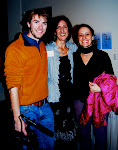Diversity, Understanding, & Reconciliation in Santa Fe
Valerie Martínez, Santa Fe Poet Laureate
©2008
Yesterday, as I drove to the College of Santa Fe, I realized that I almost always take the same route from home to office, so much so that my head leans left and right, forward and back, and so habitually that the path must be ingrained into muscles of my body. On the way, I see the same daily bicyclers and morning runners, the same train tracks, the same horizon of townhouses on Zia Road. At work my days are routine, for the most part, and I interact with many of the same people each day.
Last spring, I did things differently. Each Friday and Saturday, I traveled to Cuba, Torreon, and Ojo Encino, New Mexico to collaborate with public school students and a large group of community residents. Twice a week, eight artists from Santa Fe and Albuquerque (part of a Littleglobe, Inc. team) traveled to the Cuba area to partner with “ordinary people” to create art. To get there, I crossed several county lines and drove through some of New Mexico’s most magnificent landscapes—lizard-shaped earth formations in red and brown, pale-beige mesas, the unfolding llano. In the process, I crossed all sorts of invisible lines, too.
Cuba is a town of 9,000 with a largely Hispanic/Norteño population. Even so, Cuba High School, where we worked on Friday mornings, is about 80% Navajo, serving the outlying areas—Torreon, Counselor, Ojo Encino—and their largely Navajo populations. On Saturdays, we gathered with 45 people across the geographical, socio-economic, ethnic, and generational lines that usually divide us. There were children ages 6-11, high school students, 20-30-somethings, and others aged 40-80. We were/are White, Navajo, Hispanic/Norteño, Pueblo, Irish, Black, Japanese-American, and Mixed-Blood/Mestizo. Most have lived in the area for their entire lives. Many moved to the area many years ago. At the beginning of the project, few knew each other well.
It’s safe to say that every one of us, in this gathering, had taken a risk to be together. And it was intimidating, sometimes. I felt the force of history upon me, both pride in my Spanish
ancestry and the historical reality of Spanish oppression and violence. I felt embarrassed, sometimes, when I answered a Spanish-speaking native in my half-fluent Spanglish. I was afraid to offend the Navajo elders in the group, not knowing enough about Navajo etiquette. I made mistakes.
But, with time, fellowship did happen. We sat next to each other, ate together, sang, painted, wrote, laughed. After a couple of months, we began to have conversations about some of the historical and contemporary tensions and issues that divide us. After several months, we began to understand each other. It wasn’t something we could rush; we had to give each other time.
Back home in Santa Fe, I see that we, too, are struggling with the invisible lines of language, culture, socio-economics, ethnicity, and history that separate us. We grow increasingly diverse and, often, increasingly separate. We sometimes feel like strangers to each other, in our own home town. At the least, we feel isolated; at the most, hostile.
Because of this, and because Santa Feans often talk to me about their desire to bring our community together, we are going to have to take some risks. We need to step off the beaten path, walk across invisible lines, and spend some time with people we don’t know. It will be intimidating. We will make mistakes. It will take time. But I believe this is the first step in moving our complex, deeply-layered, and diverse city toward fellowship, understanding, and reconciliation. Si se puede.
This essay first appeared in Spanish in La Voz de Nuevo Mexico.
Subscribe to:
Post Comments (Atom)


No comments:
Post a Comment